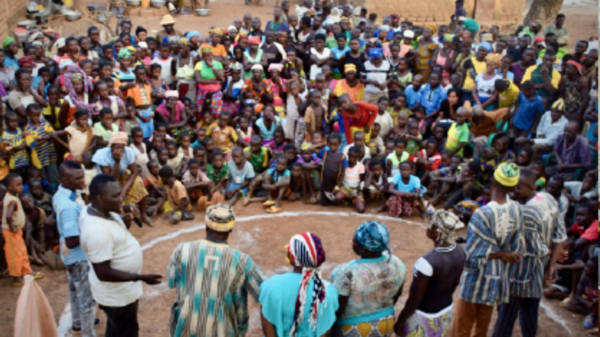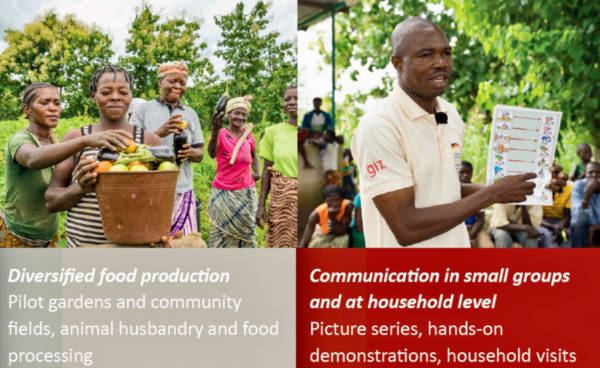Measuring Behaviour Change by Using Key Messages
An example from Burkina Faso

Mass communication: radio, theatre, movies
Photo by Michael Jooss, consultant PAH/GIZ
The Food and Nutrition Security Program in Burkina Faso is facing big challenges in changing behaviour when it comes to producing more diverse food, nutrition-related issues and overall hygiene. People from the southwest region — the project’s intervention area — are found to be particularly resistant to change in these areas, which includes several barriers in terms of the food types consumed that have an impact on the diversity of nutrition.
For example, children or women of reproductive age usually do not eat eggs because of the widespread belief it caused children to become thieves later in life. On the other hand, there are also positive aspects the project can build on, such as the availability of handwashing utensils used by the Muslim population before prayer, which are now available in nearly all households.
The approach
The project identified nutrition-related barriers and motivators using a KAP (knowledge, attitudes and practices) survey and a project baseline survey. Based on the results as well as on national documentation and policies the project formulated key messages in the areas of:
- Better nutrition
- Improved hygiene
- Increased production — plant and animal production, food storage and easy processing
Together with its partners the project agreed on ten key messages for each area. When selecting the messages, the project considered:
- The relevance of the practice
- The complexity of implementation
- The feasibility for the target group
- The availability of project funds
The formulation of the key messages aimed to be as precise, measurable and comprehensible to the target group as possible.
The messages
Only ten key messages per area were selected in order to focus on a reduced amount of information and to spread these messages to various family members via different channels, such as picture series, radio spots, films, theatre.
These communication activities were accompanied by practical demonstrations — i.e. installation of handwashing facilities, cooking demonstrations —as well as activities to improve production and processing of rich and varied food products, such as cultivation of orange-fleshed sweet potatoes, Moringa, papaya, leaf drying, production of a fortified flour mixture to produce porridge for babies.
For each key message, the project formulated a question to gauge the interviewee’s level of knowledge in relation to the message and defined a method to analyse behaviour. A key message in the hygiene area, for example, is the storage of drinking water in closed and clean containers. To assess the knowledge, the interviewer asks how drinking water must be stored. To evaluate the behaviour, the interviewer asks the interviewee to show the storage container and s/he can check him/herself whether the container is closed and clean.

Example of a key message: water storage in clean and closed containers
Source: Eau et Assainissement pour l’Afrique/Ouagadouou developed for PAH/GIZ, adapted by Damien Farma
For each of the areas, the aim is to know or apply at least seven of ten practices. On the output level knowledge of the promoted messages is measured, while on the outcome level the application rate is monitored.
What’s the project’s experience with using the approach?
Working with key messages leads to improved project activities and better monitoring, in particular:
- Key messages provide guidance for the development of activities for both project staff and partners
- The repetition of key messages in different combinations enables knowledge to be consolidated
- Dissemination of key messages to different family members and resource persons via various communication channels is possible
- Simple monitoring design: formulation of indicators that are easier to comprehend for the team and especially for the partners
- Simple implementation of the annual output assessment: the same questions can be used for all participants (target group and service providers) to measure knowledge
- Data analysis is less time consuming — Open Data Kit data is collected using tablets and can be extracted and analysed with Excel

Diverse project activities to increase knowledge and change people’s behaviour
Photo: © Michael Jooss, consultant PAH/GIZ
Unfortunately, the entire process of identifying the first key messages in the field of hygiene, developing the approach and the monitoring system and identifying and agreeing on the other key messages took almost three years. Initially, the timeframe of the project was very short (2015-2017), so the project activities started even before the concept was completed and the project missed the assessment of the baseline values for knowledge and behaviour change rates. For new projects, it is advisable to focus on developing key messages during the inception phase which will accelerate the roll-out later on.

